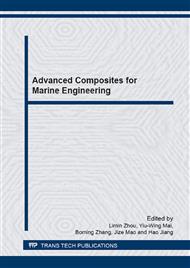p.220
p.243
p.250
p.258
p.265
p.273
p.278
p.285
p.293
A New Way to Uniform Microwave Treatment of Epoxy Glass
Abstract:
This work is part of an ambitious project aiming to manufacture epoxy-glass leaf spring by microwave processing. Physical properties of final products to be manufactured, in particular the mechanical properties, are directly dependent on uniform repartition of microwave source heating during the treatment. The major problem in microwave processing, however, is attenuation of microwave source. We propose Dielectric Effect of Attenuation Inversion of the Electromagnetic Waves (DEAI) as a new way for uniform treatment of epoxy glassmicrowave energy. This solution utilizes dielectric properties of the mold to control the microwave heat source attenuation into the composite to be treated. Electromagnetic modelling of microwave process was carried out and validated by experimental results. The results show that microwave source heating attenuation can be controlled and inversed. We demonstrated uniform treatment on epoxy-glass parts ca. 100 cm long by means of compensation of microwave source attenuation.
Info:
Periodical:
Pages:
265-272
Citation:
Online since:
March 2015
Authors:
Keywords:
Price:
Сopyright:
© 2015 Trans Tech Publications Ltd. All Rights Reserved
Share:
Citation:


